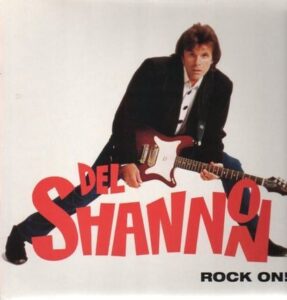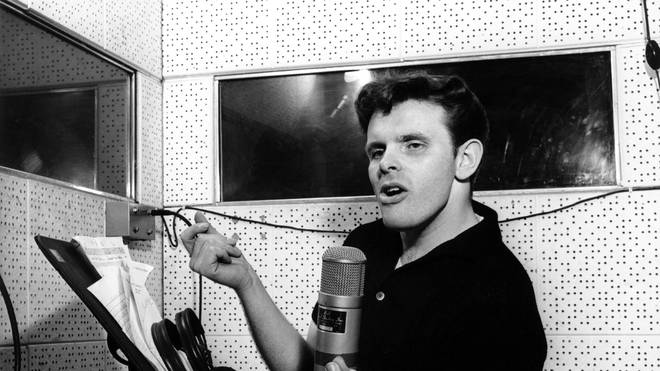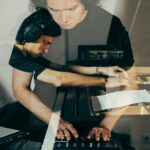I remember buying my first Del Shannon album.
It had a photo of a him on the front, and terrible graphics. He was wearing a fur guitar strap and holding his guitar like a machine gun.
He could’ve looked cheesy, but stopped short of that somehow. I picked the compilation up to have a proper look – felt a bit sorry for it, truth be told – the list of song titles on it piquing my interest.
Read Runaway and heard the tune in my head, that keyboard, an earworm if ever there was. Hats Off To Larry, one of the most spiteful jilted lover songs ever – was familiar, from a golden oldies radio station my parents listened to. I liked both songs, worth three quid of anyone’s money. So I bought it.
And I’m so glad I did.
Del Shannon Rock n Roll Greats on EMI’s Music For Pleasure imprint isn’t the definitive Del Shannon record, but has big chart hits on one side and on the other, live recordings from a show he did from Manchester on 1972.
Though it’s been joined by many of Del Shannon albums and singles since then, I’ve still got that record now, and listen to it a lot.
Like you never forget your first kiss, you never forget the first time you hear work you grow to love.
Richard Hawley discovered Del as a boy. ‘I saw him play live at a working men’s club in Sheffield in the 70s. He was amazing’.
Richard’s father Dave, a musician, ‘had all his singles, he played them a lot. Dad knew him fairly well and used to help him with his musical equipment whenever he was in town. A nice guy, very polite. He would sit with Dad and they’d talk.’
Saint Etienne’‘s Bob Stanley, author of Yeah Yeah Yeah: The Story of Modern Pop and long time Del Shannon enthusiast and champion, recalls: “It would have been Runaway. I’d like to think it was at a fairground. Along with Johnny & the Hurricanes‘ Red River Rock and Chris Montez‘s Let’s Dance, it’s the sound of a fairground.”
A Wurlitzer freakout at a British fairground is imagined in Del Shannon’s songs easily enough, and on the reverse there’s little sadder or bleaker than a British fairground closed out of season, the faces of grinning clowns and primary colours under a gloomy grey English sky.
Shannon’s very finest work carries that same uneasy, something’s not quite right here vibe, both sides of the fairground coin. His songs are infectious melodies; he was in many ways the perfect pop song writer, but no one blends melancholia within a toe tapping pop tune in quite the same way.
Del Shannon, born Charles Westover in Michigan US in December 1934, nine days before Elvis Presley came into the world, grew up with a love of country music – check out the Del Shannon Sings Hank Williams album from 1964, it will break your heart.
At 5’6″ he was short of stature, looked conventional and almost square in a way, but he wrote and recorded, and interpreted pop songs that both delight and disturb in equal measure.
The singer, songwriter, and guitarist became a star, not only in his native US but around the world, the British and Australia in particular taking him to their hearts and not letting him go, even after the chart hits ended and popularity back home tailed off.
Shannon emerged as a songwriter and maker of hits in that period between Elvis kicking open the door and The Beatles holding it wide open, waving everyone through.
People weren’t required to write their own songs yet, meaning the rock authenticity bullshittery hadn’t begun.
The teenager had been born and refused to know his place; cynical of sugary sweet hand holding ballads, leaving a window of opportunity for dark, unsettling pop songs to leak through. The era of milkshakes and girls in pointy bras and tight sweaters was one of some innocence still, certainly, but with the promise of something altogether more knowing lurking, or on its way.
“It was a time of great innovation against adversity. Anyone who was a rebel then was a rebel for the first time in a rock ‘n’ roll sense and that took real balls,’ Richard Hawley says of those brief years.
“The system was mega straight back then so to try to overthrow that was a real struggle but they did it with music. That’s a victory to me. I just love how a lot of music sounds from that era, not just the songs but how it was recorded.’
It was of course Runaway Del Shannon is best known for. Hawley describes Runaway, released in 1961, the massive hit he wrote with his keyboard player Max Crook as ‘a killer‘.
“His whole sound was totally original and largely down to himself but also Max Crook who hardly ever gets credit. He heavily adapted a monophonic clavioline and called it a Musitron– it was basically a really early synth. But Del had that insane falsetto voice that really stood out,” he adds.
The Musitron in Runaway sounds like it’s about to lose it, totally go off on one. Mentioning Del Shannon to someone recently, they looked at me quizzically but on hearing he was responsible for Runaway, they started humming Crook’s frantic, hysterical solo.
‘It’s the pivot of Runaway,’ says Bob Stanley of Crook’s contribution. ‘(it) takes it to a new level just when you think the record can’t get any better. And it’s unique.’
Runaway encapsulates Del Shannon. He was the master of songs about heartbreak, and returned repeatedly to the theme of unrequited love.
Some of his songs are deliciously vengeful, and dark, yet deftly avoid slipping into misogyny or sentimentality. He sang about lost love, and if he got the girl, then everyone else had it in for him, her or them both.
“I think of Runaway, Keep Searchin’ and Stranger In Town as a trilogy, each incrementally more intense and more mysterious, I can’t separate them. Of the lesser known songs, That’s The Way Love Is sounds on the brink of something very dark and vengeful, while Colorado Rain is like Runaway set at the end of the decade, washed up and rinsed of energy, with Del too strung out to do anything about the girl walking out on him,’”says Bob.
The world loves a tragic love song. Sad music makes us feel better, happy even. Hearing someone sing about deep emotional pain as Del did, his incredible voice swooping from damp bleak melancholy to an otherworldly falsetto that carried the hurt with it is strangely therapeutic.
He sounds lonely, in the way everyone feels sometimes.
“It’s human instinct to want to hear about someone who’s got it worse than you – that’s part of it. Relatability too, of course. But Del was more emotive and tragic than most.
“Think of a relatively recent “tragic” song, like 7 Weeks by Lukas Graham – it’s a tragic mope, whereas something like Keep Searchin’ is pure electricity. There’s just more mystery and a darker romance than anything you’ve known – it’s so exhilarating to listen to.”
I put to Richard that emotive tragic love songs go in and out of fashion.
‘They take us to places we either find hard to deal with or make us curious about the darker ends of the street. As for fashion, I have never paid much attention to that bollocks,’ he replies.
By the time The Beatles arrived in the US in 1963, Del Shannon was a household name. In his boxy shoulder padded jackets, hair moulded into an unconvincing quiff, he was a huge mainstream success, his songs of hurt and heartbreak striking a chord with the growing teenage market.
Del was canny enough to embrace the British Invasion, taking a if you can’t beat them join them approach to The Beatles, by covering From Me To You in June 1963 in the US a month after The Beatles’ original version.
In February 1967, Del went into a Olympic Studios in Southwest London with Rolling Stones producer and manager Andrew Loog Oldham to record an album, Home and Away.
The intention was to create a British response to Pet Sounds and Phil Spector’s production on River Deep Mountain High, yet the end result is a work of baroque pop beauty.
It contains three Shannon compositions. He Cheated is a classic tale of heartbreak, and there a sweet and mournful reworking of Runaway to lose yourself in. Unfortunately the singles from the sessions tanked, and by this point Loog Oldham had other things on his mind, what with new signings the Small Faces, and the Richards and Jagger Redlands drugs trial.
Del’s record label Liberty’s response was tepid due in part to a reluctance to view what was essentially a pop record as on trend, wanting something heavier instead, so the album was shelved.
“I suppose it had a 1966 Pet Sounds feel, but that didn’t stop a lot of new American acts having success with a similar sound in ’67 and even ’68 – the Blades of Grass, the Sunshine Company, the Mamas & Papas of course… I’m a sucker for a great woodwind arrangement, and there isn’t a bad song on it, it’s a fine record and more solid than any of Del‘s other albums,” comments Bob.
Later that year Del pushed further through to create the psych-pop classic The Further Adventures of Charles Westover, all his own songs.
The Home and Away sessions were released in part and with later recordings some eleven years later as And The Music Plays On, (mint copies of which are changing hands for a minimum of £50 right now) it wasn’t until 2006 the album came out in full, on CD.
‘There’s a lot of 50th anniversary competition so I’m not surprised it’s (Home and Away) gone by without comment,’ says Bob. ‘Though I’d love to have seen it come out on vinyl – I’m sure it will eventually.’
Hallelujah to that. Record label execs viewed Home and Away as too “pop”, they wanted something heavier and more rock, saw it as dated and out of time.
Richard Hawley brings up his dislike of Del’s more dated work. I’m in some agreement, but not fully.

Let’s not talk about Del’s cover of Roger Miller’s Swiss Maid (just because you can yodel in such a way and people around you tell you it’s ok, it doesn’t mean it is), and certainly 1980s and early 1990s production values – Del died in 1990, his final studio album Rock On! completed and released posthumously, produced in part by ELO’s Jeff Lynne – made his output straighter than feels right.
But I for one think it is worth looking past that. 1980s production was a curse for many; even Scott Walker didn’t escape the decade unscathed on that front; I’d have loved to have heard Del in the Travelling Wilburys as was rumoured a possibility after Roy Orbison’s death in 1988.
That aside, there is glorious work to enjoy. Makes it more of a pity Del Shannon full back catalogue isn’t available on all streaming platforms. Spotify is heavy with his big 1960s hits, and has Home and Away and a few compilation albums with puntastic titles, but nothing more than that.
The Dublin Sessions (from 1977), released for the first time a fortnight ago, isn’t available on there either. Somewhat frighteningly, Spotify does have an alarming number of karaoke backing tracks.
Of course Richard Hawley is 100% correct about not concerning ourselves about what’s trendy, but nevertheless, the truth is we don’t live in times where male singers with big voices, the voices of men not boys, are celebrated.
And one can’t help but feel that Del Shannon isn’t given the respect he deserves in the wider sense.
“With obvious exceptions, I think stars who take their own lives are generally seen as less deserving in America than stars who died young in other circumstances. Besides, Del only had a tiny number of major hits there. Britain loved him much harder, so any re-evaluation has to come from here. That’s tricky. Understandably, America doesn’t like to be told how to evaluate its pop traditions,” says Bob Stanley.
He’s not viewed as an innovator, but he was, in many ways – writing his own songs when he did, being sharp enough to cover The Beatles before anyone else thought on, having business savvy by setting up his own publishing company when he had to, and producing the work of others.
‘He was an independent operator at a time when it was rare. I’d say he was an original more than he was an innovator. I don’t think he appreciated quite how original he was.’
Rock On by Del Shannon is issued on RSD 23 April 2022 on 180g red vinyl. This the first re-issue of his final album since its original release in 1991.
This article was originally published on another platform in 2017.




